Fabergé egg: Difference between revisions
m Reverted 1 edit by 98.15.224.62 (talk) to last revision by Re5x. (TW) |
SlickVicar (talk | contribs) m →History: typo |
||
| Line 14: | Line 14: | ||
The imperial eggs enjoyed great fame, and Fabergé was commissioned to make similar eggs for a few private clients, including the [[Consuelo Vanderbilt|Duchess of Marlborough]], the [[Rothschilds|Rothschild family]] and the [[Yusupov]]s. Fabergé was also commissioned to make twelve eggs for the industrialist [[Alexander Kelch]], though only seven appear to have been completed.<ref name=enc/> |
The imperial eggs enjoyed great fame, and Fabergé was commissioned to make similar eggs for a few private clients, including the [[Consuelo Vanderbilt|Duchess of Marlborough]], the [[Rothschilds|Rothschild family]] and the [[Yusupov]]s. Fabergé was also commissioned to make twelve eggs for the industrialist [[Alexander Kelch]], though only seven appear to have been completed.<ref name=enc/> |
||
Following the revolution and the nationalization of the Fabergé workshop in St. Petersburg by the [[bolsheviks]] in 1918 |
Following the revolution and the nationalization of the Fabergé workshop in St. Petersburg by the [[bolsheviks]] in 1918, the Fabergé family left Russia. The Fabergé trademark has since been sold several times and several companies have retailed egg-related merchandise using the Fabergé name. The [[Victor Mayer]] jewelry company produced limited edition [[heirloom]] quality Fabergé eggs authorized under [[Unilever]]'s license from 1998 to 2009. The trademark is now owned by Fabergé Limited, which makes egg-themed jewellery.<ref name="Corder2011" /> |
||
In 2015 the owners of this trademark announced the creation of a new "Fabergé" egg, one styled by them as belonging to the "Imperial Class" of eggs and therefore the first Imperial-Class egg in 100 years: the [[Fabergé Pearl egg]] is to be sold in [[Qatar]] following a five-day exhibition some time in 2017. A spokesperson for the brand said it expected the egg to fetch at least two million US dollars, possibly much more. Despite its designation as "Imperial", it has no connection to Imperial Russia and instead has become closely tied to wealthy Arab [[ruling family|ruling families]] of various [[Gulf Nation|Gulf Nations]].<ref>{{cite news|newspaper=Daily Mail|date=24 February 2015|title=Faberge unveils first Imperial egg in 99 years|author=American Free Press|url=http://www.dailymail.co.uk/wires/afp/article-2967356/Faberge-unveils-Imperial-egg-99-years.html}}</ref> It's motif has been described as "scalloped", but the patterns of its curves and lines are also clearly derived from the [[girih]] and [[arabesque]] of [[Islamic interlace patterns]], and each of its six vertical segments includes a stylized pointed dome and associated [[pendentive]]s reminiscent of the [[onion dome]] and ceiling of an Arabic [[mosque]]. |
In 2015 the owners of this trademark announced the creation of a new "Fabergé" egg, one styled by them as belonging to the "Imperial Class" of eggs and therefore the first Imperial-Class egg in 100 years: the [[Fabergé Pearl egg]] is to be sold in [[Qatar]] following a five-day exhibition some time in 2017. A spokesperson for the brand said it expected the egg to fetch at least two million US dollars, possibly much more. Despite its designation as "Imperial", it has no connection to Imperial Russia and instead has become closely tied to wealthy Arab [[ruling family|ruling families]] of various [[Gulf Nation|Gulf Nations]].<ref>{{cite news|newspaper=Daily Mail|date=24 February 2015|title=Faberge unveils first Imperial egg in 99 years|author=American Free Press|url=http://www.dailymail.co.uk/wires/afp/article-2967356/Faberge-unveils-Imperial-egg-99-years.html}}</ref> It's motif has been described as "scalloped", but the patterns of its curves and lines are also clearly derived from the [[girih]] and [[arabesque]] of [[Islamic interlace patterns]], and each of its six vertical segments includes a stylized pointed dome and associated [[pendentive]]s reminiscent of the [[onion dome]] and ceiling of an Arabic [[mosque]]. |
||
Revision as of 15:38, 26 April 2017


A Fabergé egg (Russian: Яйца Фаберже́; yaytsa faberzhe) is a jeweled egg (possibly numbering as many as 69) created by the House of Fabergé. Virtually all were manufactured under the supervision of Peter Carl Fabergé between 1885 and 1917.[1] The most famous are those made for the Russian Tsars Alexander III and Nicholas II as Easter gifts for their wives and mothers (though these were not the only gifts they gave for this occasion). The House of Fabergé made 50 such "Imperial" Easter eggs, of which 43 have now numbered as extant.[1] Two planned for Easter 1917 were not delivered due to the Russian Revolution in which the Romanov Dynasty was overthrown and all the members of the imperial family executed.
Following the revolution and the nationalization of the Fabergé workshop in St. Petersburg by the bolsheviks in 1918, the Fabergé family left Russia. The Fabergé trademark has since been sold several times and several companies have retailed egg-related merchandise using the Fabergé name. The Victor Mayer jewelry company produced limited edition heirloom quality Fabergé eggs authorized under Unilever's license from 1998 to 2009. The trademark is now owned by Fabergé Limited, which makes egg-themed jewellery.[2]
History
The first Fabergé egg was crafted for Tsar Alexander III, who had decided to give his wife, the Empress Maria Fedorovna, an Easter egg in 1885, possibly to celebrate the 20th anniversary of their betrothal. Although there is no official record of the Tsar's inspiration for it, many believe that he was moved by an egg owned by the Empress’s aunt, Princess Vilhelmine Marie of Denmark, which had captivated Maria’s imagination in her childhood and of which the Tsar was well aware. Known as the Hen Egg, the very first Fabergé egg is crafted from a foundation of gold. Its opaque white enameled "shell" opens to reveal a matte yellow-gold yolk. This in turn opens to reveal a multicolored gold hen that also opens. The hen contained a minute diamond replica of the imperial crown from which a small ruby pendant was suspended, but these last two elements have been lost.[3]
Maria was so delighted by the gift that Alexander appointed Fabergé a "goldsmith by special appointment to the Imperial Crown" and commissioned another egg the next year. After that, Peter Carl Fabergé was apparently given complete freedom for the design of future imperial Easter eggs, and their designs became more elaborate. According to Fabergé family lore, not even the Tsar knew what form they would take—the only requirements were that each contain a surprise, and that each be unique. Once Fabergé had approved an initial design, the work was carried out by a team of craftsmen, among them Michael Perkhin, Henrik Wigström and Erik August Kollin.[citation needed]
After Alexander III's death on November 1, 1894, his son, Nicholas II, presented a Fabergé egg to both his wife, Alexandra Fedorovna, and his mother, the Dowager Empress Maria Fedorovna. Records have shown that of the 50 imperial Easter eggs, 20 were given to the former and 30 to the latter. Eggs were made each year except 1904 and 1905, during the Russo-Japanese War.[4]
The imperial eggs enjoyed great fame, and Fabergé was commissioned to make similar eggs for a few private clients, including the Duchess of Marlborough, the Rothschild family and the Yusupovs. Fabergé was also commissioned to make twelve eggs for the industrialist Alexander Kelch, though only seven appear to have been completed.[1]
Following the revolution and the nationalization of the Fabergé workshop in St. Petersburg by the bolsheviks in 1918, the Fabergé family left Russia. The Fabergé trademark has since been sold several times and several companies have retailed egg-related merchandise using the Fabergé name. The Victor Mayer jewelry company produced limited edition heirloom quality Fabergé eggs authorized under Unilever's license from 1998 to 2009. The trademark is now owned by Fabergé Limited, which makes egg-themed jewellery.[2]
In 2015 the owners of this trademark announced the creation of a new "Fabergé" egg, one styled by them as belonging to the "Imperial Class" of eggs and therefore the first Imperial-Class egg in 100 years: the Fabergé Pearl egg is to be sold in Qatar following a five-day exhibition some time in 2017. A spokesperson for the brand said it expected the egg to fetch at least two million US dollars, possibly much more. Despite its designation as "Imperial", it has no connection to Imperial Russia and instead has become closely tied to wealthy Arab ruling families of various Gulf Nations.[5] It's motif has been described as "scalloped", but the patterns of its curves and lines are also clearly derived from the girih and arabesque of Islamic interlace patterns, and each of its six vertical segments includes a stylized pointed dome and associated pendentives reminiscent of the onion dome and ceiling of an Arabic mosque.
List of the eggs
List of Fabergé imperial Easter eggs
Below is a chronology of the eggs made for the imperial family. The dating of the eggs has evolved over time. An earlier chronology dated the Blue Serpent Clock Egg to 1887 and identified the egg of 1895 as the Twelve Monograms Egg. The discovery of the previously lost Third Imperial Easter Egg confirms the chronology below.[6]
| Date | Egg | Image | Description | Owner |
|---|---|---|---|---|
| 1885 | Hen |  |
Also known as the Jeweled Hen Egg, it was the first in a series of 54 jeweled eggs made for the Russian Imperial family under Fabergé's supervision. It was delivered to Alexander III in 1885. The Tsarina and the Tsar enjoyed the egg so much that Alexander III ordered a new egg from Fabergé for his wife every Easter thereafter. | Viktor Vekselberg |
| 1886 | Hen with Sapphire Pendant | Also known as the Egg with Hen in Basket, it was made in 1886 for Alexander III, who presented it to his wife, the Empress Maria Feodorovna. | Lost | |
| 1887 | Third Imperial Egg |  |
A jewelled and ridged yellow gold Egg with Vacheron & Constantin watch stands on its original tripod pedestal, which has chased lion paw feet and is encircled by coloured gold garlands suspended from cabochon blue sapphires topped with rose diamond set bows. After being discovered in an American flea market, in 2014 it was purchased by London-based jeweler Wartski on behalf of an unidentified private collector.[7][8] | Private collection |
| 1888 | Cherub with Chariot | 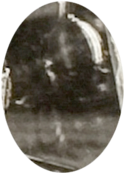 |
Also known as the Angel with Egg in Chariot, crafted and delivered in 1888 to Alexander III. This is one of the lost imperial eggs, so few details are known about it. | Lost |
| 1889 | Nécessaire | File:Nécessaire Egg.jpg | Crafted and delivered to Alexander III, who presented it to his wife, Maria Feodorovna, on Easter 1889. | Lost |
| 1890 | Danish Palaces |  |
Crafted and delivered to Alexander III, who presented it to his wife, Maria Feodorovna, on Easter 1890. | Matilda Geddings Gray Foundation, housed in the Metropolitan Museum of Art, New York City, New York, until 2016[9] |
| 1891 | Memory of Azov | 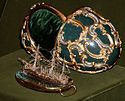 |
Kremlin Armoury, Moscow, Russia | |
| 1892 | Diamond Trellis | 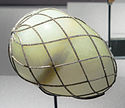 |
Dorothy and Artie McFerrin collection | |
| 1893 | Caucasus | 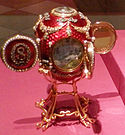 |
Matilda Geddings Gray Foundation, displayed in the Metropolitan Museum of Art, New York City, New York | |
| 1894 | Renaissance |  |
Viktor Vekselberg | |
| 1895 | Rosebud |  |
Viktor Vekselberg | |
| 1895 | Blue Serpent Clock | Before March 2014 mistaken for the third imperial egg | Albert II of Monaco collection, Monte-Carlo, Monaco | |
| 1896 | Rock Crystal | Also known as Revolving Miniatures Egg | Virginia Museum of Fine Arts | |
| 1896 | Twelve Monograms | 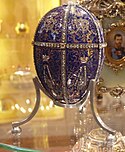 |
Also known as the Alexander III Portraits Egg.[10] Surprise is missing. | Hillwood Museum, Washington, D.C., USA |
| 1897 | Imperial Coronation Egg | 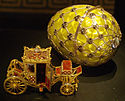 |
Viktor Vekselberg | |
| 1897 | Mauve | Only the egg's surprise has survived. | LOST Viktor Vekselberg | |
| 1898 | Lilies-of-the-Valley | 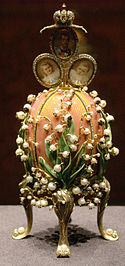 |
Made under the supervision of Fabergé in 1898 by Fabergé ateliers. The supervising goldsmith was Michael Perchin. The egg is one of two in Art Nouveau style. It was presented on April 5 to Tsar Nicholas II, and was used as a gift to the tsaritsa, Empress Alexandra Fyodorovna. | Viktor Vekselberg |
| 1898 | Pelican | File:Pelican (Fabergé egg).jpg | Virginia Museum of Fine Arts, Richmond, Virginia, US | |
| 1899 | Bouquet of Lilies Clock | 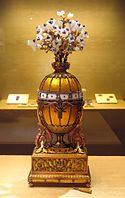 |
Kremlin Armoury, Moscow, Russia | |
| 1899 | Pansy | Matilda Gray Stream, USA | ||
| 1900 | Trans-Siberian Railway | 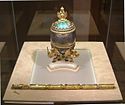 |
Kremlin Armoury, Moscow, Russia | |
| 1900 | Cockerel |  |
Viktor Vekselberg | |
| 1901 | Basket of Wild Flowers | Royal Collection, London, United Kingdom | ||
| 1901 | Gatchina Palace | 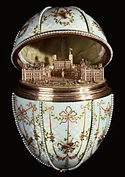 |
Walters Art Museum, Baltimore, Maryland, US | |
| 1902 | Clover Leaf | 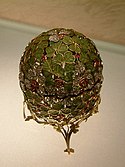 |
Kremlin Armoury, Moscow, Russia | |
| 1902 | Empire Nephrite | Private collection, New York, US | ||
| 1903 | Peter the Great | 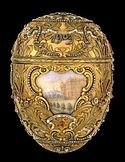 |
Virginia Museum of Fine Arts, Richmond, Virginia, US | |
| 1903 | Royal Danish | 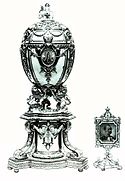 |
LOST | |
| 1904 | No eggs made | |||
| 1905 | No eggs made | |||
| 1906 | Moscow Kremlin | 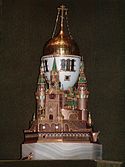 |
Kremlin Armoury, Moscow, Russia | |
| 1906 | Swan | 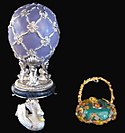 |
Edouard and Maurice Sandoz Foundation, Switzerland | |
| 1907 | Rose Trellis |  |
Walters Art Museum, Baltimore, Maryland, US | |
| 1907 | Love Trophies (also known as the "Cradle with Garlands" egg) | Private Collection | ||
| 1908 | Alexander Palace | 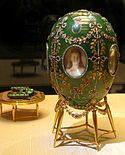 |
Kremlin Armoury, Moscow, Russia | |
| 1908 | Peacock | Edouard and Maurice Sandoz Foundation, Switzerland | ||
| 1909 | Standart Yacht | 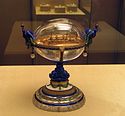 |
Kremlin Armoury, Moscow, Russia | |
| 1909 | Alexander III Commemorative | 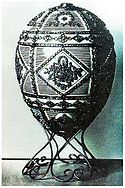 |
Lost | |
| 1910 | Colonnade | Royal Collection, London, UK | ||
| 1910 | Alexander III Equestrian | 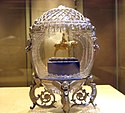 |
Kremlin Armoury, Moscow, Russia | |
| 1911 | Fifteenth Anniversary |  |
Viktor Vekselberg | |
| 1911 | Bay Tree | 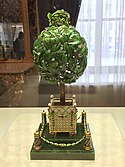 |
Also known as the Orange Tree Egg | Viktor Vekselberg |
| 1912 | Czarevich or Tsarevich |  |
Virginia Museum of Fine Arts, Richmond, Virginia, US | |
| 1912 | Napoleonic | 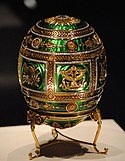 |
Matilda Geddings Gray Foundation. Displayed at the Metropolitan Museum of Art, New York, USA | |
| 1913 | Romanov Tercentenary | 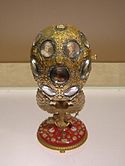 |
Kremlin Armoury, Moscow, Russia | |
| 1913 | Winter | The State of Qatar | ||
| 1914 | Mosaic | Royal Collection, London, UK | ||
| 1914 | Grisaille (also known as the "Catherine the Great Egg") | 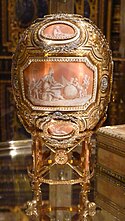 |
The egg was made by Henrik Wigström, "Fabergé's last head workmaster". It was given to Maria Feodorovna by her son Nicholas II. Its surprise (now lost) was "a mechanical sedan chair, carried by two blackamoors, with Catherine the Great seated inside".[11] | Hillwood Museum, Washington, D.C., US |
| 1915 | Red Cross with Triptych | Cleveland Museum of Art, Cleveland, Ohio, USA | ||
| 1915 | Red Cross with Imperial Portraits | 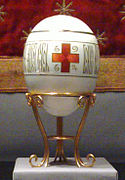 |
Virginia Museum of Fine Arts, Richmond, Virginia, USA | |
| 1916 | Steel Military | File:Faberge Steel Military.jpg | Kremlin Armoury, Moscow, Russia | |
| 1916 | Order of St. George | 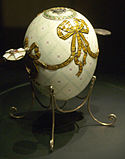 |
Made during World War I, the Order of St. George egg commemorates the Order of St. George that was awarded to Emperor Nicholas and his son, the Grand Duke Alexei Nikolaievich.[12] The Order of St. George Egg and its counterpart the Steel Military Egg were given a modest design in keeping with the austerity of World War I,[13] and Fabergé billed 13,347 rubles for the two.[12] The Order of St. George egg left Bolshevik Russia with its original recipient, the Dowager Empress Maria Feodorovna.[14] | Viktor Vekselberg |
| 1917 | Karelian Birch | Created in 1917, the egg was due to be completed and delivered to the Tsar that Easter, as a present for his mother, the Empress Maria Feodorovna. But before the egg could be delivered, the February Revolution took place and Nicholas II was forced to abdicate on March 15. On April 25, Fabergé sent the Tsar an invoice for the egg, addressing Nicholas II not as "Tsar of all the Russians" but as "Mr. Romanov, Nikolai Aleksandrovich". Nicholas paid 12,500 rubles and the egg was sent to Grand Duke Michael Alexandrovich at his palace, for presentation to the empress, but the duke fled before it arrived. The egg remained in the palace until it was looted in the wake of the October Revolution later that year. | Alexander Ivanov. Displayed at Ivanov's Fabergé Museum in Baden-Baden, Germany. | |
| 1917 | Constellation (unfinished) | 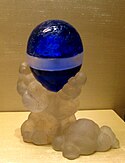 |
Because of the Russian Revolution of 1917, this egg was never finished or presented to Nicholas's wife, the Tsaritsa Alexandra Feodorovna. Two eggs have claims to be the Constellation Egg: one held at Fersman Mineralogical Museum in Moscow and the other in the possession of Alexander Ivanov and displayed at Ivanov's Fabergé Museum in Baden-Baden, Germany. | Fersman Mineralogical Museum, Moscow or the Fabergé Museum in Baden-Baden. |
List of the Kelch eggs
Faberge was also commissioned to make twelve eggs for Alexander Ferdinandovich Kelch, a Siberian gold mine industrialist, as gifts for his wife Barbara (Varvara) Kelch-Bazanova. Though still "Fabergé eggs" by virtue of having been produced by his workshop, these eggs were not as elaborate as the imperial eggs, and were not unique in design. Most are copies of other eggs.
| Date | Egg | Image | Description | Owner |
|---|---|---|---|---|
| 1898 | Hen | Viktor Vekselberg | ||
| 1899 | Twelve Panel | Royal Collection, London, UK | ||
| 1900 | Pine Cone | Private collection | ||
| 1901 | Apple Blossom |  |
Private collection | |
| 1902 | Rocaille | 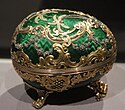 |
Dorothy and Artie McFerrin collection | |
| 1903 | Bonbonnière | Private collection | ||
| 1904 | Chanticleer | Viktor Vekselberg |
Other Fabergé eggs
| Date | Egg | Image | Description | Owner |
|---|---|---|---|---|
| 1885–91 | Blue Striped Enamel | Private collection | ||
| 1902 | Duchess of Marlborough | 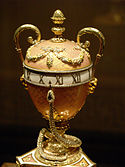 |
Viktor Vekselberg | |
| 1902 | Rothschild | Hermitage Museum, Saint Petersburg, Russia | ||
| 1907 | Youssoupov | Edouard and Maurice Sandoz Foundation, Switzerland | ||
| 1914 | Nobel Ice | 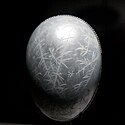 |
Dorothy and Artie McFerrin collection | |
| 1885–89 | Resurrection |  |
Viktor Vekselberg | |
| 1899–1903 | Spring Flowers | 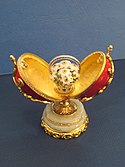 |
Possibly inauthentic | Viktor Vekselberg |
| 1899–1903 | Scandinavian |  |
Viktor Vekselberg | |
| 2017 | Pearl | Covered in 139 fine white pearls and more than 3,000 diamonds | House of Fabergé |
Location of eggs
Of the 65 known Fabergé eggs,[note 1] 57 have survived to the present day. Ten of the imperial Easter eggs are displayed at Moscow's Kremlin Armory Museum. Of the 50 known imperial eggs, 43 have survived, and there are photographs of three of the seven lost eggs: the 1903 Royal Danish Egg, the 1909 Alexander III Commemorative Egg, and the Nécessaire Egg of 1889. The previously lost Third Imperial Easter Egg of 1887 has since been found in the US and bought by Wartski for a private collector.[15]
After the Russian Revolution, the Bolsheviks nationalized the House of Fabergé, and the Fabergé family fled to Switzerland, where Peter Carl Fabergé died in 1920.[16] The imperial family's palaces were ransacked and their treasures moved to the Kremlin Armoury on order of Vladimir Lenin.[16]
In a bid to acquire more foreign currency, Joseph Stalin had many of the eggs sold in 1927, after their value had been appraised by Agathon Fabergé. Between 1930 and 1933, 14 imperial eggs left Russia. Many of the eggs were sold to Armand Hammer (president of Occidental Petroleum and a personal friend of Lenin, whose father was founder of the United States Communist Party) and to Emanuel Snowman of the London antique dealers Wartski.
After the collection in the Kremlin Armoury, the largest gathering of Fabergé eggs was assembled by Malcolm Forbes, and displayed in New York City. Totaling nine eggs, and approximately 180 other Fabergé objects, the collection was to be put up for auction at Sotheby's in February 2004 by Forbes' heirs. However, before the auction began, the collection was purchased in its entirety by the oligarch Victor Vekselberg.[17] In a 2013 BBC Four documentary, Vekselberg revealed he had spent just over $100 million purchasing the nine Fabergé eggs.[18] He claims never to have displayed them in his home, saying he bought them as they are important to Russian history and culture, and he believed them to be the best jewelry art in the world. In the same BBC documentary Vekselberg revealed he plans to open a museum that will display the eggs in his collection,[18] which was built as a private museum Fabergé Museum in Saint Petersburg, Russia on November 19, 2013.[note 2][19]
In November 2007, a Fabergé clock, named by Christie's auction house the Rothschild Egg, sold at auction for £8.9 million (including commission).[20] The price achieved by the egg set three auction records: it is the most expensive timepiece, Russian object, and Fabergé object ever sold at auction, surpassing the $9.6 million sale of the 1913 Winter Egg in 2002.[21][22]
In 1989, as part of the San Diego Arts Festival, 26 Faberge eggs were loaned for display at the San Diego Museum of Art, the largest exhibition of Faberge eggs anywhere since the Russian Revolution.[23] The eggs included eight from the Kremlin,[note 3] nine from the Forbes collection,[note 4] three from the New Orleans Museum of Art,[note 5] two from the Royal Collection[note 6] one from the Cleveland Museum of Art[note 7] and three from private collections.[note 8]
Location of the imperial eggs
Location of the Kelch Eggs
| Location/Owner | Image | Number of Eggs | Eggs in collection |
|---|---|---|---|
| Viktor Vekselberg's Link of Times foundation, Fabergé Museum in Saint Petersburg, Russia |
 |
2 | Kelch Hen, Chanticleer |
| Royal Collection, London, UK |  |
1 | Twelve Panel |
| Separate private collections | 4 | Pine Cone, Apple Blossom, Rocaille, Bonbonniére |
Location of the other eggs
| Location/owner | Image | Number of eggs | Eggs in collection |
|---|---|---|---|
| Viktor Vekselberg's Link of Times foundation, Fabergé Museum in Saint Petersburg, Russia |
 |
4 | Duchess of Marlborough, Resurrection, Spring Flowers, Scandinavian |
| Edouard and Maurice Sandoz Foundation, Lausanne, Switzerland | 1 | Youssoupov | |
| Hermitage Museum, Saint Petersburg, Russia |  |
1 | Rothschild |
| Separate private collections | 2 | Blue Striped Enamel, Nobel Ice |
In popular culture
Fabergé eggs have become symbols of the splendour, power and wealth of the Romanov dynasty and the Russian Empire, priceless treasures to hunt, steal, etc. As such, they have been part of the plot in several films and television series, such as Octopussy (1983), Love Among Thieves (1987), Murder She Wrote episode "An Egg to Die For" (1994), Case Closed: The Last Wizard of the Century (1999), The Order (2001), Ocean's Twelve (2004), The Simpsons episodes "'Round Springfield" (1995) and "The Last of the Red Hat Mamas" (2005), the Family Guy episode "Stu and Stewie's Excellent Adventure" (2006), Thick as Thieves (2009), American Dad! episode "A Jones for a Smith" (2010), The Intouchables (2011), Hustle episode "Eat Yourself Slender" (2012), Scooby Doo! Mystery Incorporated episode "The House of the Nightmare Witch" (2012),[24] Imperial Eight (2015),[25] Person of Interest episode "Search and Destroy" (2015), etc. In Danielle Steele's "Zoya", a Fabergé egg is a keepsake of the last two remaining members of a noble family. The Lilies of the Valley egg was depicted in an episode of the British crime drama, Peaky Blinders, season 3 episode 5 (2016). The digital card game Cabals: Magic & Battle Cards features Fabergé egg as a collectable card.
See also
Notes
- ^ the 50 delivered Imperial eggs, the Karelian Birch Egg, the seven Kelch eggs, the Duchess of Marlborough, the Rothschild, the Youssoupov, Nobel, Resurrection, Spring Flowers, and Blue Striped Enamel eggs—total 65
- ^ The foundation supporting the Fabergé Museum in Saint Petersburg is the Link of Times foundation, which has been repatriated lost cultural valuables to Russia.
- ^ Memory of Azov, Bouquet of Lilies Clock, Trans-Siberian Railway, Alexander Palace, Standart Yacht, Alexander III Equestrian, Romanov Tercentenary, and Steel Military
- ^ Renaissance, Rosebud, Coronation, Lilies of the Valley, Cockerel, Bay Tree, Fifteenth Anniversary, Order of St. George, and Spring Flowers
- ^ Danish Palaces, Caucasus, and Napoleonic
- ^ Colonnade and Mosaic
- ^ Red Cross with Triptych
- ^ Pansy, Love Trophies, and Blue Striped Enamel
References
- ^ a b c New World Encyclopedia (12 October 2013). "Fabergé egg".
- ^ a b Corder, Rob (2011-11-18). "Faberge: A Regal Renaissance". ProfessionalJeweller.com. Retrieved 2012-03-26.
- ^ "Article on the first Hen egg". wintraecken.nl. 2008-11-13. Retrieved 2012-03-26.
- ^ "Current whereabouts of the fifty Fabergé Imperial eggs". pbs.org. 1999. Retrieved 2016-01-20.
- ^ American Free Press (24 February 2015). "Faberge unveils first Imperial egg in 99 years". Daily Mail.
- ^ Wartski.com Archived July 4, 2014, at the Wayback Machine
- ^ Singh, Anita (18 March 2014). "The £20m Fabergé egg that was almost sold for scrap". The Telegraph. Retrieved 19 March 2014.
- ^ http://www.dailymail.co.uk/news/article-2588521/How-DID-20million-royal-treasure-end-bric-brac-stall-Faberge-egg-lost-Russian-Tsar-shot-dead-emerged-American-flea-market.html
- ^ "Fabergé from the Matilda Geddings Gray Foundation Collection November 22, 2011–November 27, 2016". Museum of Modern Art. Retrieved 2015-09-05.
- ^ Hillwood Museum have identified the Twelve Monograms Egg previously dated to 1895 as the Alexander III Portraits Egg of 1896, Artdaily.com
- ^ Hillwood Estate, Museum & Gardens - The Catherine the Great Egg
- ^ a b Faberge - Treasures of Imperial Russia
- ^ "Mieks Fabergé Eggs". May 2016.
- ^ "Faberge". Treasures of Imperial Russia. Retrieved 2012-03-26.
- ^ Singh, Anita (18 Mar 2014). "The £20m Fabergé egg that was almost sold for scrap". The Telegraph. Retrieved 18 March 2014.
- ^ a b "Faberge Eggs - the fate of the eggs". Pbs.org. Retrieved 2012-03-26.
- ^ "Buying Putin's Indulgences". Energy Tribune. Archived from the original on 2007-11-14. Retrieved 2012-03-26.
{{cite web}}: Unknown parameter|deadurl=ignored (|url-status=suggested) (help) - ^ a b "The World's Most Beautiful Eggs: The Genius of Carl Faberge" BBC FOUR
- ^ "Home Page". The Link of Times foundation. Retrieved 5 September 2015.
- ^ The clock was previously documented and had been published in 1964 in L'Objet 1900 by Maurice Rheims, plate 29
- ^ Fabergé egg sold for record £8.9m, BBC News, 28 November 2007
- ^ Varoli, John (2007-11-28). "Muse Arts". Bloomberg.com. Retrieved 2012-03-26.
- ^ "ANTIQUES; Not Imperial, but Still Faberge". The New York Times. May 28, 1989.
- ^ Cook, Victor (2012-07-31), The House of the Nightmare Witch, retrieved 2016-03-29
- ^ Road's End Films
Further reading
- Faber, Tony (2008). Fabergé's Eggs: The Extraordinary Story of the Masterpieces That Outlived an Empire. New York: Random House. ISBN 978-1-4000-6550-9.
- Hill, Gerald (2007). Fabergé and the Russian Master Goldsmiths. New York: Universe. ISBN 978-0-7893-9970-0.
External links
- Fabergé Imperial Egg Chronology at Fabergé Research Site by Christel Ludewig McCanless
- Empress Marie Feodorovna's Missing Fabergé Easter Eggs, article by Annemiek Wintraecken and Christel Ludewing McCanless
- Playlist on Fabergé eggs; documentaries, lectures, etc.
- Details on each of the Fabergé Eggs
- BYU article on the eggs
- Site by Annemiek Wintraecken, details on each of the Fabergé Eggs










